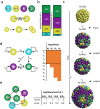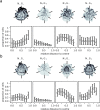Cell fate clusters in ICM organoids arise from cell fate heredity and division: a modelling approach
- PMID: 33376253
- PMCID: PMC7772343
- DOI: 10.1038/s41598-020-80141-3
Cell fate clusters in ICM organoids arise from cell fate heredity and division: a modelling approach
Abstract
During the mammalian preimplantation phase, cells undergo two subsequent cell fate decisions. During the first decision, the trophectoderm and the inner cell mass are formed. Subsequently, the inner cell mass segregates into the epiblast and the primitive endoderm. Inner cell mass organoids represent an experimental model system, mimicking the second cell fate decision. It has been shown that cells of the same fate tend to cluster stronger than expected for random cell fate decisions. Three major processes are hypothesised to contribute to the cell fate arrangements: (1) chemical signalling; (2) cell sorting; and (3) cell proliferation. In order to quantify the influence of cell proliferation on the observed cell lineage type clustering, we developed an agent-based model accounting for mechanical cell-cell interaction, i.e. adhesion and repulsion, cell division, stochastic cell fate decision and cell fate heredity. The model supports the hypothesis that initial cell fate acquisition is a stochastically driven process, taking place in the early development of inner cell mass organoids. Further, we show that the observed neighbourhood structures can emerge solely due to cell fate heredity during cell division.
Conflict of interest statement
The authors declare no competing interests.
Figures




Similar articles
-
Mouse ICM Organoids Reveal Three-Dimensional Cell Fate Clustering.Biophys J. 2019 Jan 8;116(1):127-141. doi: 10.1016/j.bpj.2018.11.011. Epub 2018 Nov 16. Biophys J. 2019. PMID: 30514631 Free PMC article.
-
Allocation of inner cells to epiblast vs primitive endoderm in the mouse embryo is biased but not determined by the round of asymmetric divisions (8→16- and 16→32-cells).Dev Biol. 2014 Jan 1;385(1):136-48. doi: 10.1016/j.ydbio.2013.09.008. Epub 2013 Sep 13. Dev Biol. 2014. PMID: 24041854
-
HIPPO pathway members restrict SOX2 to the inner cell mass where it promotes ICM fates in the mouse blastocyst.PLoS Genet. 2014 Oct 23;10(10):e1004618. doi: 10.1371/journal.pgen.1004618. eCollection 2014 Oct. PLoS Genet. 2014. PMID: 25340657 Free PMC article.
-
Anatomy of a blastocyst: cell behaviors driving cell fate choice and morphogenesis in the early mouse embryo.Genesis. 2013 Apr;51(4):219-33. doi: 10.1002/dvg.22368. Epub 2013 Feb 25. Genesis. 2013. PMID: 23349011 Free PMC article. Review.
-
Capturing Identity and Fate Ex Vivo: Stem Cells from the Mouse Blastocyst.Curr Top Dev Biol. 2016;120:361-400. doi: 10.1016/bs.ctdb.2016.04.007. Epub 2016 May 31. Curr Top Dev Biol. 2016. PMID: 27475857 Review.
Cited by
-
AI-powered simulation-based inference of a genuinely spatial-stochastic gene regulation model of early mouse embryogenesis.PLoS Comput Biol. 2024 Nov 14;20(11):e1012473. doi: 10.1371/journal.pcbi.1012473. eCollection 2024 Nov. PLoS Comput Biol. 2024. PMID: 39541410 Free PMC article.
-
Initial source of heterogeneity in a model for cell fate decision in the early mammalian embryo.Interface Focus. 2022 Jun 10;12(4):20220010. doi: 10.1098/rsfs.2022.0010. eCollection 2022 Aug 6. Interface Focus. 2022. PMID: 35865503 Free PMC article.
-
Adjusting the range of cell-cell communication enables fine-tuning of cell fate patterns from checkerboard to engulfing.J Math Biol. 2023 Sep 7;87(4):54. doi: 10.1007/s00285-023-01959-9. J Math Biol. 2023. PMID: 37679573 Free PMC article.
-
The transition from local to global patterns governs the differentiation of mouse blastocysts.PLoS One. 2020 May 15;15(5):e0233030. doi: 10.1371/journal.pone.0233030. eCollection 2020. PLoS One. 2020. PMID: 32413083 Free PMC article.
-
Long-term live imaging and multiscale analysis identify heterogeneity and core principles of epithelial organoid morphogenesis.BMC Biol. 2021 Feb 24;19(1):37. doi: 10.1186/s12915-021-00958-w. BMC Biol. 2021. PMID: 33627108 Free PMC article.
References
-
- Downs KM, Davies T. Staging of gastrulating mouse embryos by morphological landmarks in the dissecting microscope. Development. 1993;118:1255–1266. - PubMed
-
- Tarkowski AK, Wróblewska J. Development of blastomeres of mouse eggs isolated at the 4-and 8-cell stage. Development. 1967;18:155–180. - PubMed
-
- Johnson, M. H. & McConnell, J. M. Lineage allocation and cell polarity during mouse embryogenesis. In Seminars in Cell & Developmental Biology, vol. 15, 583–597 (Elsevier, Amsterdam, 2004). - PubMed
Publication types
MeSH terms
LinkOut - more resources
Full Text Sources

